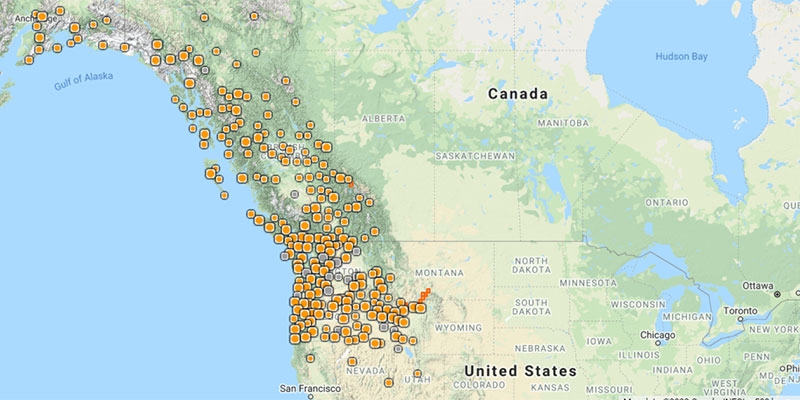Red Columbine
Botanical Name
Aquilegia formosa
Pronunciation
(ack-wi-LEE-gee-uh for-mo-sah)
Common Name
red columbine
Family
Ranunculaceae
Growth Form
herbaceous, taprooted
Life Cycle
perennial
Habitat
meadows, open forests
Red columbine’s unique red and yellow flowers rise 2-3′ above a lower layer of delicate soft green foliage. This perennial blooms in mid-late spring, later followed by capsules bearing shiny black seeds. They are typically found in open meadow areas or forest edges throughout the pacific northwest.
With nectar located at the end of the five, tubular spurs of each flower, this plant is a favorite of pollinators with long tongues, such as hummingbirds and butterflies; though bumblebees may “cheat” and make holes in the outside of the spurs to get to the nectar. Birds enjoy both the seeds later in summer and fall and various caterpillars that might be feeding on the foliage.
In the garden, columbine can survive in a variety of conditions, but does best in a partially shady area with somewhat moist soil, such as a transition from sun to shade. They are non aggressive, relatively short-lived, but also self-sow readily.
Gardening
Flowering Period
May-August, depends on elevation and seasonal variation
Flower Color
red/yellow
Height and Spread
up to 4′ high and 2′ wide
Light Requirements
full-sun to part-shade
Water Requirements
moist to dry
Soil Preference
well-drained
Garden Habit
short lived, not aggressive, self sows
Wildlife Benefits
nectar/pollen for hummingbirds, butterflies, bees, numerous beneficial insects; foliage supports caterpillars; birds enjoy seeds and caterpillars
Nursery Production
Seed Propagation
- Seed Collection
Collect in early summer when follicles begin drying, turning brown, and seed can be heard rattling inside. Collect entire follicle and store in cloth bag or open container until dry, brittle and seeds fall out. - Seed Cleaning
Much seed can be easily separated by just dumping seed out of follicles that have split open. Bits of chaff can be separated from seed using a fan or gentle blowing. - Seeds per gram
560 (15800/oz) - Additional Info
It hybridizes readily with other cultivated Aquilegias if they are in the vicinity. Hybridized plants will typically have a different flower color and a slightly different leaf shape with fewer toothed margins. - Pre Sowing Treatments
Seeds are soaked 24 h with aquarium bubbler; cold stratification (40F/5C), 120-150 days. Continue to check seed as germination can occur in cold stratification. - Seed Dormancy Type
Physiological - Sowing
Timing
Remove from cold stratification and sow either when germination begins in strat, or at the end of required cold days. Optimal timing at Oxbow has been Feb/March
Container
7 cubic inch container (Ray-Leach, Steuwe and Sons, Tangent, OR)
Seeds/Cell
5-6 - Germination
Seed will often begin germination in cold stratification; typically above ground germination begins within 2-4 wks of sowing, and continues approximately 4 wks; germination rates medium. - A-sexual Propagation
Division of big clumps is possible.
Growing Out
- Irrigation
Plants can tolerate drying out, but keep moist during active growth periods. - Growth Rate
Medium - Special Planting Instructions
AQFO has a large taproot but it transplants well if it is not severly cut. - Growing Conditions
Can grow in partial or full sun. - Pruning or Cutting Back
It needs to be cut back frequently during the growing season as leaves deteriorate or become covered by powdery mildew. Plants will quickly recover and grow new leaves.
Pests and Diseases
- Insect Pests
aphids, columbine sawfly, leafminers - Diseases
powdery mildew


